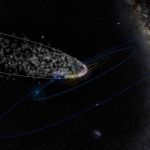Dominique Luchart's Blog, page 615
May 24, 2021
Finding life on alien worlds? PBS Nova’s Exoplanet Lab game tells you how!, ,

Rescue aliens and cats in distress while learning about the search for life on alien worlds in a new game from PBS!
Part of the science series NOVA, the “Exoplanet Lab” game helps tweens and young teens to better understand what makes exoplanets habitable like Earth. Players will learn about the conditions that allow exoplanets to have liquid water, which is essential for life as we know it to exist, NOVA said in a statement emailed to Space.com.
The game is free to play and available immediately in your web browser. Tailored training modules will take players through the journey of learning how to find and characterize exoplanets throughout the galaxy, and how to compare their conditions to those on Earth..
Related: 10 exoplanets that could host alien life
“Through a series of videos and simulation tools, players — called ‘NOVAnauts’ in the game — learn about the conditions that make Earth suitable for life, and what to look for in other, distant star systems in our Milky Way galaxy,” NOVA said in the statement.
“Astrophysicists and astronomers Moiya McTier, Clara Sousa-Silva, Anjali Tripathi, Theron Carmichael, and David Berardo make appearances to explain the real techniques that are being modeled in the game.”
Players will then embark on a series of missions mimicking the work of real scientists “to find new homes for fictional alien species,” the statement added.
In the first mission,players will meet the fictional Plantae, described as “sentient photosynthetic creatures” that are looking to settle in a new world rich in carbon dioxide. Players will need to figure out the volume, mass and atmospheric composition of exoplanets to ensure the new homes can sustain the aliens.
[image error]
A few of the aliens you’ll encounter in the NOVA Exoplanet Lab. (Image credit: NOVA Labs/PBS)Subsequent missions cover tidally locked planets (planets with one side perpetually facing their star) and a request from Earth’s cats to find a planet where they can rule without the bother of living with dogs or humans. Keep your eye out for bonus missions including squid-like and sloth-like alien creatures. All exoplanet profiles are logged in a visual journal for players.
“We’re big believers in playful learning, giving students opportunities to think like scientists while also having some fun,” David Condon, NOVA Labs editorial director, said in the statement. “Exoplanets are incredibly cool, and I think we’ve found a great way to integrate a lot of science into a very engaging narrative with this game.”
Previously, NOVA labs has tackled solar weather predictions with its Sun Lab game and the development of renewable energy with the game Energy Lab.
Follow Elizabeth Howell on Twitter @howellspace. Follow us on Twitter @Spacedotcom and on Facebook.
Join our Space Forums to keep talking space on the latest missions, night sky and more! And if you have a news tip, correction or comment, let us know at: community@space.com.
The post Finding life on alien worlds? PBS Nova’s Exoplanet Lab game tells you how!, , appeared first on NEWDAWN Blog.
Scientists track meteor shower to unusual comet seen every 4,000 years, ,

Meteor showers are the dazzling result of cometary debris building up along well-worn paths through the solar system, then burning up in Earth’s atmosphere as our planet crosses that dust trail.
It’s hard to call a path well-worn when something passes by only once every 3,967 years. But it turns out that type of long-period comet can still be tied to a specific meteor shower, as scientists have done with Comet C/2002 Y1 Juels-Holvorcem and the UY Lyncids shower. The research that connected the long haul ice ball and the shower triples the number of celestial displays that scientists have tied to specific comets that take more than 250 years to orbit the sun.
“Until recently, we only knew five long-period comets to be parent bodies to one of our meteor showers,” Peter Jenniskens, a meteor astronomer at the SETI Institute and the lead author of the new research, said in a statement. “But now we identified nine more, and perhaps as many as 15.”
Related: How to see the best meteor showers of 2021
For some perspective, Comet C/2002 Y1 Juels-Holvorcem most recently made a close approach of the sun in 2003 — which means its last such visit was around 2,000 B.C., when Egypt’s Great Pyramids were just a few hundred years old, and its next pass of the sun won’t occur until nearly the year 6,000.
Typically, a shorter orbit means a comet retraces its path more regularly, scattering more rubble that can become more “shooting stars” when Earth plows through the debris. That means it’s difficult for skywatchers to notice meteor showers caused by comets with orbits beyond about 250 years or so.
The best known long-period comet that triggers a meteor shower is comet C/1861 G1 Thatcher, which causes the April Lyrid meteor shower. Other long-period comets’ showers are less dramatic, even those scientists had previously identified, like the Aurigids (debris from C/1911 N1 Kiess) and the Leonis Minorids (from C/1739 K1 Zanotti).
The scientists behind the new study wanted to find more such connections, so they turned to a program called Cameras for Allsky Meteor Surveillance (CAMS), which includes observation stations across the United States and around the globe, including in New Zealand, Namibia, Chile and the United Arab Emirates — networks totalling more than 500 individual cameras all told, all watching for meteors.
“These are the shooting stars you see with the naked eye,” Jenniskens said. “By tracing their approach direction, these maps show the sky and the universe around us in a very different light.”
Related: Amazing photos of Comet NEOWISE from the Earth and space
Looking at such huge amounts of meteor sightings, scientists can pick out subtle meteor showers based on tracking only a few shooting stars to similar origin points in the sky, called radiants. So astronomers combined that analysis of a decade of observations with NASA’s database of comets and their orbits.
The scientists found at least nine new matches between meteor showers and long-period comets, and identified another six potential matches. The research tracks down the comets responsible for esoteric meteor showers, like December’s sigma Virginids and July’s Pegasids, caused by debris from C/1846 J1 Brorsen and C/1979 Y1 Bradfield respectively.
Most of the comets in the research swing past the sun every 400 to 800 years or so, a quite respectable calendar. Three comets joined Juels-Holvorcem is a bit of an outlier with orbits longer than 1,000 years. Scientists have tied a few other long-period comets to specific meteor showers, but can’t quite pin down their orbital periods.
Among the meteor showers studied, the researchers noticed an intriguing trend: Displays from long-period comets tend to last several days, and the radiant appears to move like a smudge on the sky. The scientists on the new research think the effect may be caused by a comet’s orbit shifting between loops, so that the rubble fields don’t align as cleanly as they do for short-period comets.
“This was a surprise to me,” Jenniskens said. “It probably means that these comets returned to the solar system many times in the past, while their orbits gradually changed over time.”
The research is described in a paper that will be published this autumn by the journal Icarus.
Email Meghan Bartels at mbartels@space.com or fo
The post Scientists track meteor shower to unusual comet seen every 4,000 years, , appeared first on NEWDAWN Blog.
GPS satellites can provide faster alerts when big earthquakes strike, scientists say, ,

A global GPS-based earthquake monitoring system can provide timelier and more accurate warnings than traditional seismic networks when powerful earthquakes strike, a new study suggests. It could also reduce frequency of false alerts.
In the new study, published this month in the Bulletin of Seismological Society of America, a team of researchers detailed new progress in the development of a global earthquake warning system that measures the displacement of Global Positioning System (GPS) satellite receiver stations when an earthquake deforms the Earth’s crust. The system assesses the magnitude of an earthquake within seconds and issues alerts in under two minutes from the first detection of the ground movement.
According to lead author Timothy Melbourne, professor of geology at Central Washington University, the GPS-based detection system can provide earlier and more accurate alerts than the traditional seismic sensors distributed in tectonically active regions, which can be overwhelmed with an initial surge of data when seismic waves first emerge.
Related: Earthquakes in Puerto Rico changed the landscape. Satellites see it from space.
“The problem is that when earthquakes get very big, the seismic networks traditionally have a very hard time understanding what has happened in the first minutes after the event,” Melbourne told Space.com. “What you find even with a medium-sized earthquake is a very complicated seismic trace. The seismic waves radiate into the earth, they bounce around inside the earth, and interact with structures. It gets really complicated to tease out what was the source of the waves versus what is the effect of all the reverberations in the crust.”
Seismologists, Melbourne added, usually wait for the waves to spread further away from the center and scale the earthquake from afar. But waiting is not an option with the threat of high-magnitude earthquakes and potentially devastating tsunamis that could kill thousands of people.
In 2019, for example, the U.S. earthquake warning app ShakeAlert failed to warn Los Angeles citizens when a magnitude-6.4 earthquake hit Southern California on Independence Day because it incorrectly assessed the force of the tremors. On the other hand, false alerts can trigger panic and reduce trust in the system in the future.
“That’s what happened in Japan in 2011,” Melbourne said. “The tsunami sirens went off, all the warnings happened, but they had had three or four of those in the previous years. So people didn’t take it seriously.”
The GPS-based monitoring system, which measures the accurate position of the receiver, doesn’t have to deal with the tangle of seismic waves. It measures how much the earthquake deformed the ground, shifting the position of the receivers.
“If you go back through catalogs in the last 20 years, and look at a plot of how much the ground deformed versus the magnitude of the earthquake, it’s extremely linear,” Melbourne said. “In Tohoku (the region closest to the epicenter of the 2011 earthquake in Japan), some of the [GNSS] stations moved over five meters.”
The receivers send the signal in real time via the internet, cellular or satellite networks to the central system, which evaluates the shift within seconds and informs local authorities about the scale of the earthquake.
Melbourne says the effectiveness of the GPS-based system (it can use data from other navigation satellite systems, or GNSS, too) in the early assessments of powerful earthquakes lies in its “bluntness” and limited sensitivity compared to the seismic sensors.
“It’s like listening to an orchestra and only wanting to know how loud it is,” Melbourne said. “You don’t want to hear the violins or the French horns, you only want to make that one measurement.”
Scientists have studied movements of the Earth’s crustal plates using GPS data since the 1980. But a truly global early warning space-based system has only become possible fairly recently, Melbourne said, thanks to the proliferation of fixed GPS stations, frequently used for land-surveying and construction work.
“The speed at which the global distribution of GPS receivers is growing is astonishing,” Melbourne said. “It’s growing by thousands of new stations a year and these all provide very high-quality positioning data.”
In the future, the system might be able to incorporate data from smartphones and mobile devices. Although these are designed to move around, artificial intelligence algorithms already exist that would be able to distinguish patterns typical for Earth tremors, Melbourne added.
For now, the researchers are trying to convince countries from around the globe to share data from their stations to enable alerts and help improve the science behind the technology. The research is detailed in the May 11 edition of the Bulletin of the Seismological Society of America.
Follow Tereza Pultarova on Twitter @TerezaPultarova. Follow us on Twitter @Spacedotcom and on Facebook.
The post GPS satellites can provide faster alerts when big earthquakes strike, scientists say, , appeared first on NEWDAWN Blog.
Metro Exodus on PC adds support for PS5 controller’s amazing adaptive triggers,

Metro Exodus has become one of the first PC games to support the PS5 DualSense controller’s haptic feedback and adaptive triggers thanks to a recent patch. Although many PC games already support the PS5 controller’s basic features, with Valve adding support for it to its Steam Input API last year, Metro Exodus now supports its advanced haptics, as well as its trigger features, which add extra resistance depending on what you’re doing in-game.
Videos posted by Twitter user @mrdomino_ and VGC‘s Andy Robinson show the feature in action, including showing the controller’s right trigger springing back with the recoil from various weapons. It’s nothing new compared to what we’ve seen from native PS5 games like Returnal, but it’s great to see that same functionality replicated on PC.
PS5’s DualSense is now fully functional on PC, via Metro Exodus’ latest update. pic.twitter.com/97yVVYYIJy
— Andy Robinson (@AndyPlaytonic)
The patch means Metro Exodus‘s full support for the controller has actually arrived on PC before the PS5 itself. The official PS5 version of the game isn’t due to release until June 18th, when it will include full support for the controller’s haptic features alongside other features like ray tracing.
There appears to be a couple of downsides for PC players, however, with VGC reporting that the advanced DualSense features only seem to work over a wired connection, and not wirelessly. Tom’s Hardware also reports that the feature is exclusive to the Steam version of the game, and won’t work on purchases from the Epic Games Store or GOG. We’ve followed up with the game’s publisher for confirmation.
The post Metro Exodus on PC adds support for PS5 controller’s amazing adaptive triggers, appeared first on NEWDAWN Blog.
Ford’s F-150 Lightning Pro is an electric pickup truck for businesses, Sean O’Kane

 Image: Ford
Image: FordFord has revealed a version of its new F-150 Lightning electric pickup truck aimed specifically at commercial customers. It’s called the F-150 Lightning Pro, and it starts at $39,974 for a version with an estimated 230 miles of range. Extended-range versions of the truck, which are expected to get 300 miles on a full battery, will start at $49,974.
Much like the retail version of the electric F-150, the Lightning Pro stands to win Ford a lot of business as long as the company executes well when the truck starts shipping in 2022. Fleets all over the country are already considering a switch to electric vehicles, either to get ahead of zero-emission guidelines at the state or federal level, or in an attempt to take advantage of what should…
The post Ford’s F-150 Lightning Pro is an electric pickup truck for businesses, Sean O’Kane appeared first on NEWDAWN Blog.
Ford’s F-150 Lightning Pro is an electric pickup truck for businesses,

Ford has revealed a version of its new F-150 Lightning electric pickup truck aimed specifically at commercial customers. It’s called the F-150 Lightning Pro, and it starts at $39,974 for a version with an estimated 230 miles of range. Extended-range versions of the truck, which are expected to get 300 miles on a full battery, will start at $49,974.
Much like the retail version of the electric F-150, the Lightning Pro stands to win Ford a lot of business as long as the company executes well when the truck starts shipping in 2022. Fleets all over the country are already considering a switch to electric vehicles, either to get ahead of zero-emission guidelines at the state or federal level, or in an attempt to take advantage of what should be a lower total cost of ownership with electric vehicles. Ford claims the Lightning Pro could cut maintenance costs up to 40 percent over eight years and 100,000 miles of use compared to a 2.7L EcoBoost F-150.
Multiple electric pickups are coming to market over the next year or two, including Tesla’s Cybertruck, the GMC Hummer EV, and the Rivian R1T. But almost none are geared specifically towards commercial fleets. One of the only examples is the electric pickup truck being developed by Ohio startup Lordstown Motors. That truck is supposed to go into production later this year, but it will start at around $52,000, and the company doesn’t have anywhere near the track record of an established automaker like Ford. Paired with the E-Transit van, the Lightning Pro gives Ford a potent one-two punch in the fight to electrify the commercial market.
There aren’t a lot of obvious differences between the Lightning Pro and the retail versions of the electric F-150 that Ford revealed last week. Like the retail version, it only comes in a four-door SuperCrew cab and 5.5-foot bed configuration. Buyers can choose to equip the Lightning Pro with the standard or extended range battery. The standard range version will have a max 7,700-pound towing capacity when equipped with the optional towing package, while the extended range can pull up to 10,000 pounds. Both versions use a dual-motor, all-wheel drive setup, with the standard range truck maxing out at an estimated 426 horsepower, while the extended range version can make around 563HP.
Both Lightning Pro trucks have onboard power available, which can run electric tools or other accessories, though buyers will have to pay more for extra outlets (including a 240 volt plug in the bed) and higher total output. The extended range option also comes with an 80-amp charging station that can pretty much help refill a truck’s battery overnight. All versions of the commercial truck come with the massive, water-resistant front trunk, which has 14.1 cubic feet of storage and its own set of electrical outlets.
There is one big difference between the commercial and retail versions, though: the Lightning Pro will come with Ford’s commercial telematics software, which makes it easier for fleet owners to keep tabs on the location, charging status, or health of their vehicles.
“It’s actually complimentary for customers, and it gives insights such as: what’s your odometer [at]? What warning lights and diagnostic trouble codes are there? And we’re going so far as to provide preventative and proactive prognostics,” says Alex Purdy, the head of connectivity on Ford’s business operations side. Purdy says Ford even offers a data service that works with any other third-party fleet telematics software businesses might already have up and running.
Ford’s fleet software will also help operators tackle some of the more unconventional issues that might crop up as they switch to electric vehicles. For instance, some workers take their fleet vehicles home at night, fill up the gas tank on their own, and get reimbursed by their employer. Ford could help install home chargers for those workers, Purdy says, but the company has also written into the fleet software a way to let employers reimburse workers for the cost of at-home charging.
“These are the kinds of things that make Ford different,” Purdy says. “We say that we know how people use their vehicles, and it feels like a hollow thing — it’s not actually hollow in this case at all, because there are unique challenges with making an electric vehicle, relevant, useful, and adoptable by commercial customers.”
The post Ford’s F-150 Lightning Pro is an electric pickup truck for businesses, appeared first on NEWDAWN Blog.
May 23, 2021
Samsung announces bigger and smaller versions of its TV-like Smart Monitor,

Samsung’s Smart Monitor range is expanding. The company’s line of Tizen-powered smart computer displays now includes a 43-inch 4K M7 model as well as a 24-inch 1080p M5, marking the biggest and smallest Smart Monitors to be made available to date.
Samsung introduced the Smart Monitor last year and describes it as a “do-it-all” display designed for both work and entertainment. The screens have built-in speakers and smart TV functionality through Samsung’s Tizen platform, meaning you can run video apps like Netflix directly on the device, as well as remote desktop access and productivity software like Office 365. The Smart Monitors have a remote control that works with Alexa, Google Assistant, and Bixby, and there’s also wireless support for DeX, Samsung’s desktop-style environment that runs on Galaxy smartphones.
The M7 series now includes 43-inch and 32-inch 4K options. The M5 series uses 1080p panels and comes in 24-inch, 27-inch, and 32-inch sizes. Samsung is also introducing a white version of the 27-inch and 32-inch M5 Smart Monitor.
Samsung hasn’t announced pricing yet for the new models, but for context, the 32-inch M7 was released at $399.99 while the 27-inch M5 was $229.99, so you can probably expect prices slightly above and below those two extremes.
The post Samsung announces bigger and smaller versions of its TV-like Smart Monitor, appeared first on NEWDAWN Blog.
Samsung announces bigger and smaller versions of its TV-like Smart Monitor, Sam Byford


Samsung’s Smart Monitor range is expanding. The company’s line of Tizen-powered smart computer displays now includes a 43-inch 4K M7 model as well as a 24-inch 1080p M5, marking the biggest and smallest Smart Monitors to be made available to date.
Samsung introduced the Smart Monitor last year and describes it as a “do-it-all” display designed for both work and entertainment. The screens have built-in speakers and smart TV functionality through Samsung’s Tizen platform, meaning you can run video apps like Netflix directly on the device, as well as remote desktop access and productivity software like Office 365. The Smart Monitors have a remote control that works with Alexa, Google Assistant, and Bixby, and there’s also wireless support…
The post Samsung announces bigger and smaller versions of its TV-like Smart Monitor, Sam Byford appeared first on NEWDAWN Blog.
May 22, 2021
Virgin Galactic spaceplane VSS Unity completes successful flight,

Richard Branson’sVirgin Galactic completed its first successful space flight in more than two years on Saturday, with its crewed VSS Unity spacecraft carried to an altitude of more than 44,000 feet before gliding safely back to Earth. It marked the first spaceflight from New Mexico, making it the third US state to launch humans into space. The Zia sun symbol of New Mexico’s state flag was displayed on the outside of the ship.
Virgin’s VMS Eve carrier aircraft took off from Spaceport America in New Mexico at about 10:35AM ET with Unity aboard. About 10 minutes before its release, Unity switched to its own battery power, and conducted flight control and electrical checks. Once released by Eve, Unity’s pilots C.J. Sturckow and Dave Mackay ignited the rocket motor, then shut it down a few minutes later, with the spacecraft’s momentum keeping it traveling toward its apogee, or highest point.
Unity reached a speed of Mach 3 after it was released from Eve, and reached space at an altitude of 55.45 miles. It reached apogee at about 11:30AM ET, did a slow turn, then glided back into Earth’s atmosphere, landing at about 11:43 AM ET on the same Spaceport America runway where its flight began.
Today’s view: Infinite. #Unity21 made a beautiful ascent to apogee over Spaceport America, New Mexico. #VirginGalactic pic.twitter.com/jphjbMbSr2
— Virgin Galactic (@virgingalactic)
“It was picture perfect,” Virgin Galactic CEO Michael Colglazier told The Verge in a phone interview Saturday after Unity and Eve were back on the ground. “We’re gonna go through the data deeply and thoroughly as we always do.” In a statement, Colglazier called the flight a “major step forward for both Virgin Galactic and human spaceflight in New Mexico,” which had never hosted a crewed test mission to space until today.
“You’ve never seen a mix of more proud parent engineers,” Colglazier said of Virgin Galactic’s engineering team. Dozens of company employees gathered to watch the test flight under clear blue skies at Spaceport America, the company’s HQ for future commercial missions. Champagne was popped to celebrate the craft’s landing and Branson, the company’s billionaire founder, was “electrified” to see it all play out, Colglazier said.
Saturday’s flight, which also carried research payloads for NASA’s Flight Opportunities program, is the latest step toward Virgin Galactic’s goal of a space tourism program. The company has some 600 reservations for tickets on future space flights, which go for around $250,000 each. Unity is able to carry up to six passengers and two pilots.
It was Virgin Galactic’s first space flight since 2019, and the third one it’s completed. Unity’s first two flights, in late 2018 and early 2019, were conducted at the company’s test facility at the Mojave Air and Spaceport out of California. Virgin Galactic later moved its operations to Spaceport America, where it plans to conduct all of its commercial tourist flights. The company had to abort its first flight attempt at the new facility in December, after Unity’s engine cut out early ahead of its glide back to Earth due to what the company later said was electromagnetic interference.
VSS Unity’s flight on Saturday featured some hardware upgrades installed since the December abort scenario, including a new digital controller that the pilots used for tighter handling. “This was our first run with it under full power, and it was flawless. Spot on,” Colglazier said. That controller will be used on SpaceShipThree, the company’s upgraded spacecraft tailored for routine production.
Virgin Galactic said in February, and confirmed during its May 10th earnings call, that it has a total of four spaceflights planned this year. The next one is slated to have two pilots and four Virgin Galactic employees as passengers, and a third flight is scheduled to have Virgin founder Richard Branson on board. Flight four is intended to be a commercial flight for the Italian Air Force, which should generate $2 million in revenue.
Saturday’s flight was the 400th commercial space launch licensed by the FAA. The dates for the future Unity flights are still to be announced.
Update May 22nd 2:17PM ET: Adds details from Virgin Galactic about the flight
Update May 22nd 5:51PM ET : Adds interview with Virgin Galactic CEO and more details about Unity
The post Virgin Galactic spaceplane VSS Unity completes successful flight, appeared first on NEWDAWN Blog.
Aerion Supersonic, which planned to make silent, fast business jets, is shutting down,

Aerion Supersonic, which had plans to build silent business jets that would travel twice as fast as most commercial airplanes, is shutting down operations. First reported by Florida Today, Aerion, which had backing from Boeing, said it was unable to raise the money to build its AS2 supersonic jet.
“The AS2 supersonic business jet program meets all market, technical, regulatory and sustainability requirements and the market for a new supersonic segment of general aviation has been validated with $11.2 billion in sales backlog for the AS2,” the company said in an statement emailed to The Verge on Saturday.
“However, in the current financial environment, it has proven hugely challenging to close on the scheduled and necessary large new capital requirements to finalize the transition of the AS2 into production. Given these conditions the Aerion Corporation is now taking the appropriate steps in consideration of this ongoing financial environment.”
Aerion CEO Tom Vice said in January 2020 that the AS2 would likely cost about $4 billion for the company to develop, CNBC reported. At that time, it had already spent $1 billion to develop the AS2’s engine. And in April 2020, Florida Governor Ron DeSantis announced Aerion was relocating its headquarters from Reno, Nevada to Melbourne, Florida, at a plant to be built at Orlando Melbourne International Airport.
Earlier this year, Bloomberg reported Aerion was in talks to go public via a special purpose acquisition company, or SPAC. Those talks apparently did not come to fruition.
The company’s AS2 was intended to travel at around 1,000 miles per hour, and its patented “boomless cruise” technology would have allowed it to fly without creating a sonic boom. The company had planned to fly its first AS2 by 2024, and begin commercial flights by 2026.
The post Aerion Supersonic, which planned to make silent, fast business jets, is shutting down, appeared first on NEWDAWN Blog.



